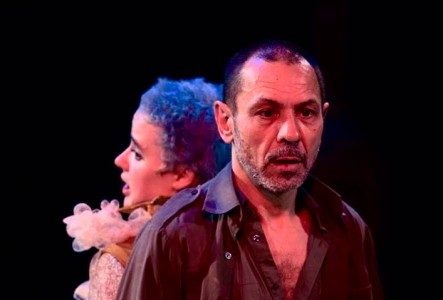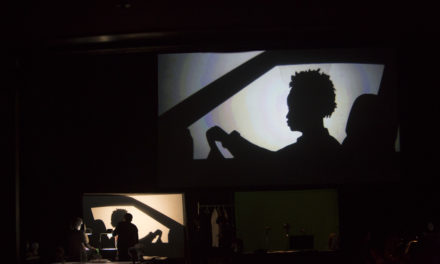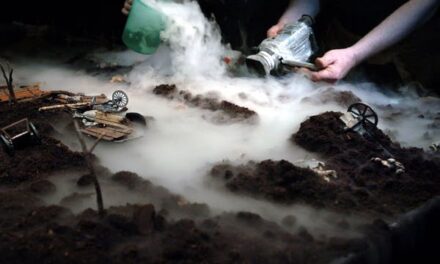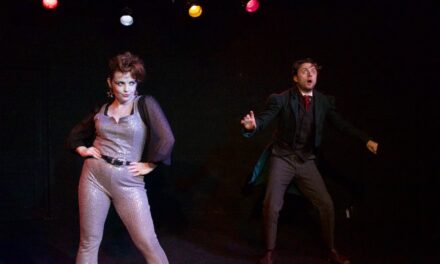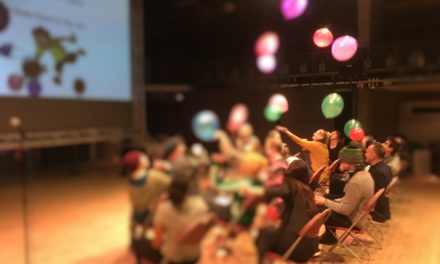The Little Prince–the classic novella by Antoine de Saint-Exupéry–is about a pilot stranded in the Sahara desert, visited there by a child, the Little Prince of the title. The two form a friendship, and The Pilot learns of the life of his visitor, who hails from a tiny asteroid, in turn sharing his own story of passionate love for a Rose. Translated into 250 languages, the book has sold around 150 million copies globally: one of the best-selling works ever published. What’s made it so successful has been the pairing of its unconventional, fable-tone with ambitious thoughts on the ephemeral nature of life and of failed love. These universal themes, when captured this poignantly, seem to come from a kind of genius–surely what’s made the novella such an extraordinary, international success.
This imaginative adaptation by Xameleon Theatre is broadly successful too, and a fitting translation to the stage. The direness of The Pilot’s crisis, downplayed in the novella, here becomes explicit, with Oleg Sidorchik–seemingly gruff–showing himself as a protagonist full of life and pathos. The galactic, blue-haired Zinovyeva injects the role of the Prince with the arachnoid energy of a little boy. Their relationship is an active, charged one, and they work well together.

Xameleon Theatre Productions
The Pilot’s Russianness comes off too and always seems natural, gaining an ironic quality and shrugging away French melancholy. There are moments that have us giggling, such as the Pilot’s massacre of the audience with a bubble machine, and scenes of considerable ingenuity too. As we see the Little Prince visiting six different planets–all of which embody some aspect of the human condition (vanity, drudgery, and so on)–director Ovlyakuli Khodzhakuli’s inventiveness comes to the fore (the Pilot’s engine morphing into the Lamplighter’s planet is a case in point). Most profound is the play’s ending: as bizarre harp tones point to the culmination of the action, and the dust of the desert blows in squalls, the Pilot and his beloved Rose embrace in a Spanish dance, an optimistic ending for the Pilot himself and again, a sign of notable originality on the part of the director.
Certainly, there are things one can bridle at here: there surely should have been an English program–the play was advertised as suitable for non-Russian speakers and the Cockpit Theatre is a British venue. The costumes felt a bit too literal at times as well: this should be the case for The Pilot but certainly not for The Rose, whose sweatsuit was a note of bathos. And though the use of the same actor both as Pilot and every proprietor of each of the planets visited by the Prince worked well, the tripling up of the Rose as both Snake and Fox illuminated little, the latter character presented as more openly malign than in Saint-Exupéry’s novella, undermining the book’s even-handedness and subtlety.
Luckily, The Little Prince’s simplicity primes it for adaptation, and this was generally borne out here. Though lacking the vulnerability of the novella, Xameleon’s production was sensitive and thought-provoking, not to mention laugh-out-loud funny at times. One senses that the real Saint-Exupéry, a man of humor himself, would have approved.
This post originally appeared on CEEL.org.uk on March 22, 2017, and has been reposted with permission.
This post was written by the author in their personal capacity.The opinions expressed in this article are the author’s own and do not reflect the view of The Theatre Times, their staff or collaborators.
This post was written by Andreea Scridon.
The views expressed here belong to the author and do not necessarily reflect our views and opinions.

